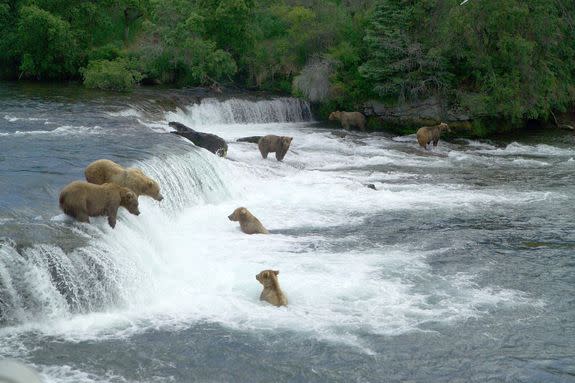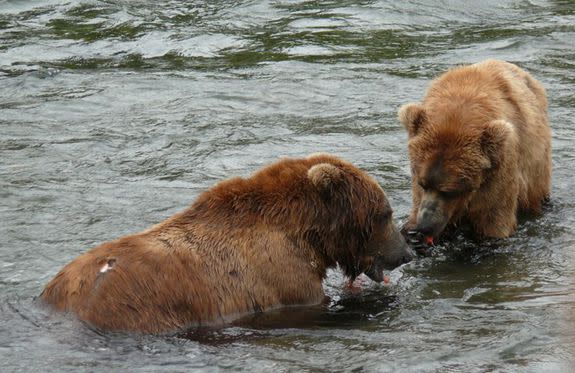A dominant brown bear has returned to the Alaska bear cam, seeking fish and females

Bear 747, one of the largest and most dominant Brooks River bears, has returned to his fishing grounds.
The brown bear is one of the first spotted this year on the five webcams positioned along the salmon-rich river in Katmai National Park, Alaska.
Former Katmai ranger Mike Fitz, who has returned to the park to report on the bears for explore.org — the philanthropic organization that sets up and supports bear cam — said he spied 747 recently, and has seen other dominant bears beginning to roam the verdant area.
SEE ALSO: From puffins to brown bears: The 10 best wildlife livestreams of the summer
Throughout most of June — which is considered the high mating season — the river is empty and the bear watching slow.
But come July, the 1.5-mile river teems with silver sockeye salmon, and the bears feast as the live webcams watch on.
Bear 747, given that number by park biologists, is an expected summertime visitor to the Brooks River. Biologists identified him as a subadult, or teenage bear, in 2004, and provided him a number he quickly grew into.
These brown bears can reach 1,000 pounds, and 747 is about as big as they come. After months of eating fatty fish this summer, 747 will likely become one of the heftiest bears on the river, if not the fattest of them all.
And in the bear world, big means dominant.
747 isn't without his competitors, but he has consistently been a top bear, and commands the prime fishing spots. Last year, when he eventually showed up, he proved quite formidable, according to Katmai National Park.

Image: nps
"In 2017, #747 was not regularly seen at Brooks Falls until fall," reads the park's 2018 Brooks River bears guide. "After arriving, he was commonly seen displacing the largest, most dominant bears and yielding to none."
At times, over 20 brown bears have been observed fishing at the Brooks River falls, though as the season progresses, the bears will fish in other parts of the river as well.
To spot the dominant bears come July, look at the large males likely sitting below the falls who grab salmon in their claws and teeth as the fish accumulate beneath the waterfall.

Image: mike fitz/nps
Each fish contains about 4,500 calories, and in July when the fish are plentiful, many bears like 747 may just eat the fattiest parts — the brains, skin, and eggs — leaving the rest for smaller or younger bears to scavenge.
The days are long in subarctic Alaska this time of year, so there's much time for viewing these wild creatures over the webcam.
Checking out the live stream from your couch is much easier than taking a floatplane to the remote park, landing on a glacial lake, and avoiding the bears roaming the beach while trying to make it to the ranger station.
This is deep bear country, so keep an eye out. The bears are coming.
WATCH: Ever wonder how the universe might end?


